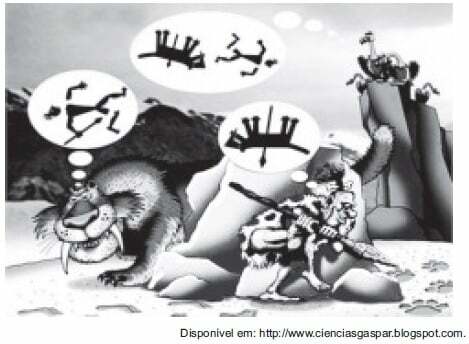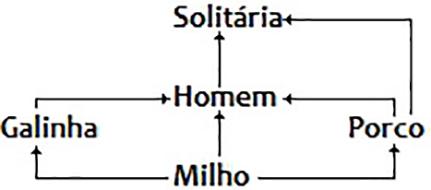A food web represents the set of food chains so that the flow to obtain energy from living beings is effected within the ecosystems.
We prepared a list of food web exercises so you can test your knowledge of trophic levels.
see more
Biology teacher fired after class on XX and XY chromosomes;…
Cannabidiol found in common plant in Brazil brings new perspective…
You can consult the feedback and save this list of exercises in PDF at the end of the post!
Food web exercises
1) (ENEM) The characters in the figure are representing a hypothetical food chain situation.
 The figure represents an example of a food chain. Suppose that, in a scene prior to the one presented, the man has fed on fruits and grains that he managed to collect. Assuming that, in the next scenes, the tiger is successful and, subsequently, serves as food for the vultures, the tiger and the vultures will occupy, respectively, the trophic levels of:
The figure represents an example of a food chain. Suppose that, in a scene prior to the one presented, the man has fed on fruits and grains that he managed to collect. Assuming that, in the next scenes, the tiger is successful and, subsequently, serves as food for the vultures, the tiger and the vultures will occupy, respectively, the trophic levels of:
a) producer and primary consumer.
b) primary consumer and secondary consumer.
c) secondary consumer and tertiary consumer.
d) tertiary consumer and producer.
e) secondary consumer and primary consumer.
2)(UFAL) The diagram below shows the trophic relationships in a rural property.

Note the trophic relationships above. According to the scheme, the man is:
a) producer.
b) primary consumer only.
c) secondary consumer only.
d) tertiary consumer only.
e) primary and secondary consumer.
3) (UFRGS) Consider the following statements about trophic levels.
I – Herbivores feed on organisms found at various trophic levels.
II – Detritivores, as they feed on the remains of other organisms, are not part of food chains.
III – The main energy source of the producing organisms is solar energy.
Which ones are correct?
a) I only.
b) III only.
c) Only I and II.
d) Only II and III.
e) I, II and III.
4) (CESGRANRIO) A cavy that lived on the edge of a pond, feeding on grass, was captured by a snake that was later caught by a hawk. But the story could be different, and the hawk could have hunted a mouse or another bird. In turn, the snake could have captured a bird that had eaten an insect.
With reference to the food web, mark the correct alternative:
a) The energy contained in the producer gradually decreases as it passes from consumer to consumer.
b) The energy of the producer gradually increases in the different elements of the food chain.
c) The energy potential of the producer does not change in the different segments of the food chain.
d) In the food web, as the animals are of different sizes, the energy quantity of the producer suffers oscillations.
e) The complexity of the food web does not interfere with the amount of energy transferred, which remains unchanged.
5) Food webs, unlike trophic chains, represent all existing food relationships in an ecosystem. Given this, organisms in a web can assume different trophic levels. However, autotrophic organisms always occupy the level of:
a) decomposers.
b) producers.
c) primary consumers.
d) secondary consumers.
e) tertiary consumers.
6) Analyze the food web below:
 Regarding this web, mark the correct alternative.
Regarding this web, mark the correct alternative.
a) In the web represented in the question, grass is the primary consumer.
b) In the web above, the chicken acts as a secondary and primary consumer, depending on the analyzed chain.
c) In the represented web, man occupies the position of primary and tertiary consumer, depending on the analyzed chain.
d) The ox and the grasshopper are the only primary consumers of the represented web.
e) The hawk occupies only the tertiary consumer classification.
7) (UFSCar) In the late 1970s, biological communities were discovered living at the bottom of the oceans, in depths of 2,500 meters, close to cracks through which hot magma leaks out, superheating the surrounding water. These communities are formed mainly by bacteria that obtain energy by oxidizing H‚S formed in the crevices and by animals that feed on them. Among the animals in these communities are gigantic tube worms, over 1 meter in length. length, which nourish themselves at the expense of chemosynthetic bacteria that live as symbionts within their bodies.
In these underwater communities, the bacteria that obtain energy by oxidizing H‚S and the giant worms mentioned in the text act, respectively, as:
a) primary producers and consumers.
b) producers and decomposers.
c) primary consumers and secondary consumers.
d) decomposers and producers.
e) decomposers and primary consumers.
8) Food webs, like food chains, have different trophic levels. The main difference, however, is that organisms can occupy different levels in a food web. Regarding webs, mark the incorrect alternative:
a) The food web can be defined as a set of food chains in an ecosystem.
b) In the representation of a food web, decomposers are often not mentioned, as they act at all levels.
c) In food webs, the secondary consumer can also occupy the position of quaternary consumer, for example.
d) In food webs, the representation of feeding relationships follows a linear sequence.
e) In food webs, it is possible to perceive the presence of producers, consumers and decomposers.
9) (PUC-SP) “In the Pantanal, aquatic plants serve as food for lambaris, pacus and capybaras. In this environment, piranhas feed on lambaris and pacus. The giant otters survive, feeding on pacus and piranhas.”
In the food web described in the excerpt above, organisms occupying two trophic levels are:
a) lambaris.
b) pacus.
c) capybaras.
d) piranhas.
e) giant otters.
10) It is common to have webs and food chains without the representation of decomposers. This happens because:
a) decomposers do not act at all trophic levels.
b) decomposers act only on consumers.
c) decomposers act at all trophic levels.
d) decomposers act only on producers.
feedback
1 — c
2 — and
3 — b
4 — the
5 — b
6 — d
7 — the
8 — d
9 and
10 — c
Click here to save this list of exercises in PDF!
See too:
- List of exercises on leaf adaptations
- List of exercises on angiosperms
- List of exercises on the earth's atmosphere

